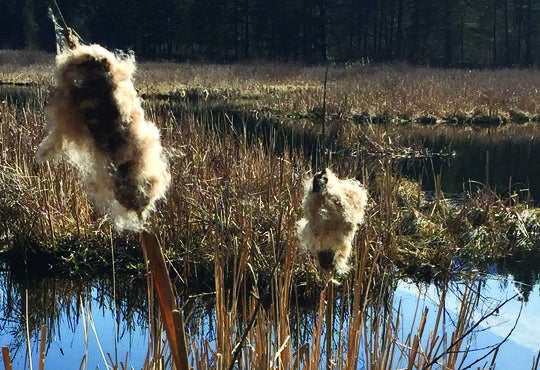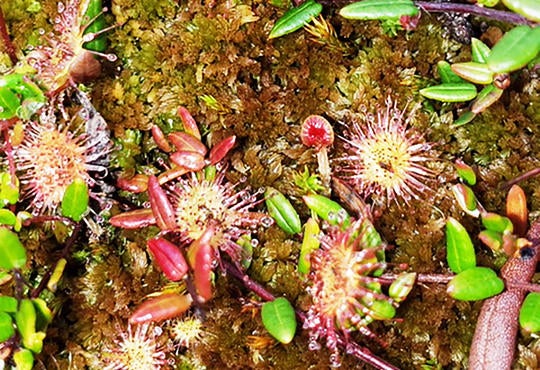 In permafrost landscapes, wetlands, ponds, and lakes are ubiquitous and important features that support biodiversity, high productivity and long-term carbon storage. With climate warming, thermokarst lake expansion may modify the ability of these aquatic systems to maintain ecological functions, as a consequence of changes to nutrient inputs, hydrochemistry, water level, and land aridity.
In permafrost landscapes, wetlands, ponds, and lakes are ubiquitous and important features that support biodiversity, high productivity and long-term carbon storage. With climate warming, thermokarst lake expansion may modify the ability of these aquatic systems to maintain ecological functions, as a consequence of changes to nutrient inputs, hydrochemistry, water level, and land aridity.
Frisbee Pond is located in the western Hudson Bay Lowlands, Canada, a transition zone between open tundra and the northern edge of the boreal forest (Figure 1). The regional climate is strongly influenced by the proximity of Hudson Bay and is a continuous permafrost zone with an active layer depth of 0.4 to 1 m. The landscape is poorly drained because of low relief and the confining nature of permafrost, which leads to the prevalence of small, closed-basin, shallow ponds and lakes. Frisbee Pond underwent thermokarst-driven shoreline expansion throughout the period 2006-2008 leading to the inundation of land that became incorporated into the lake.
In this study, we used the thermokarst shoreline expansion at Frisbee Pond to assess the extent of changes to sediment nutrient accumulation, nutrient isotope values and community structure of diatom algae attributable to the event. More specifically, we hypothesized that the expansion caused increased organic matter supply from the adjacent land to the lake, which would be reflected in a shift in nutrient origin and accumulation, and changes in isotope values in the pond sediment towards those of terrestrial material.

FIGURE 1: Frisbee Pond basin; the undisturbed pond perimeter prior to the thermokarst event is highlighted in a thick black outline, whereas the extent of the thermokarst shoreline slump is evident in the photo.
Methodology
Hydroclimate data for the region were acquired for local stations from Environment and Climate Change Canada. A 29 cm long sediment core was collected from Frisbee Pond in 2015, approximately seven to nine years after thermokarst expansion. In order to estimate sediment ages and sedimentation rates, a 210Pb chronology was constructed for the core using standard methods and application of the constant rate of supply model. The sediment core was analyzed for diatom assemblage composition, total nutrient (carbon, nitrogen, and phosphorus) accumulation rates, and stable isotopes of organic carbon (δ13C) and nitrogen (δ15N).
Outcomes
Investigations of hydroclimate conditions prior to the shoreline slump indicate warming of summer air temperatures and an increase in precipitation over the long-term mean, consistent with changing climate conditions that caused thermokarst disturbance in other permafrost environments.
Results suggest that, in Frisbee Pond, thaw-driven shoreline slumping altered nutrient accumulation rates and led to an increase in total diatom accumulation, although the timing of increased nutrient sedimentation appears to have begun prior to slumping. While the bulk sediment accumulation rate increased several years prior to the event (between around 2000-2004), the ratio of mineral/organic sediment did not change in the predominantly organic pond sediment. Changing carbon and nitrogen isotope values following the disturbance indicate a shift in the sources of these elements to the sediment, towards greater carbon supply from the land and nitrogen from the atmosphere (Figure 2).

FIGURE 2: Carbon, nitrogen, phosphorus, and diatom accumulation rates in the sediment core from Frisbee Pond (~ 1940-2015). The thermokarst event of 2006-2008 is highlighted with a horizontal red line.
Results indicate that the shoreline expansion caused an increase in total diatom accumulation. However, while the bulk sediment accumulation rate continued to increase for up to seven years following the disturbance, the increase in the diatom accumulation rate peaked shortly after disturbance and stabilized thereafter as can be seen in Figure 2.
Shifts in nutrient inputs altered diatom community composition several decades prior to the thermokarst event, including an increase in the relative abundance of Denticula kuetzingii, a species that prefers relatively productive lake conditions. These compositions appear not to have changed substantially immediately prior to, or as a result of, the shoreline slump (Figure 3).

FIGURE 3: Relative diatom abundance over time in the Frisbee Pond sediment core. The timing of the thermokarst event is indicated by the gray dashed line at 2 cm depth.
Conclusions
This study has important implications for understanding hydro-ecological responses of small surface water bodies to general climate forcing, in combination with rapid thermokarst shoreline expansion, under a changing climate. It confirmed that an increase in nutrient accumulation, triggered by slumping of terrestrial material into Frisbee Pond, led to an increase in total diatom accumulation, although the rise in sedimentation began prior to the shoreline slump. Shifts in diatom assemblages prior to and during the disturbance were similar to changes reported in other northern environments caused by general climate forcing, which may mask the effect of thermokarst activity on diatom ecology. The source of organic carbon shifted strongly towards a terrestrial origin following the thermokarst event, and this shift persisted throughout the subsequent seven year period, after which it did not return to the pre-disturbance value. The hydroclimate conditions preceding the thermokarst expansion were consistent with conditions that led to catastrophic thaw in other permafrost catchments with sustained higher than average precipitation, coupled with warming temperatures.
In this study, the thermokarst event was preceded by a decade of warming temperatures and sustained increased precipitation. Results of these disturbances may leave a “combined” signal in the sediment record, even if the effect of each is distinct. For instance, climate change is gradual relative to the rapid impact of a shoreline disturbance event. Permafrost thaw and thermokarst processes have been attributed to similar hydroclimate conditions in several other northern catchments, and are commonly interpreted as the capacity to thermally disturb permafrost and hydrologically connect near-shore material to the pond, respectively. Thus, the extent of thermal permafrost disturbance on nutrient dynamics could be limited by the hydrologic connection of the disturbed area to larger hydrologic transport networks. Given that the diatom community composition changed several decades prior to the thermokarst event in Frisbee Pond, results from other studies may be required to evaluate the extent to which diatom changes were driven by general climatic forcing.
Future research should investigate the relationship between the spatial extent and longevity of disturbance and lake response. Whereas this work explored the response of a single, small catchment to thermokarst disturbance, such perturbations are projected to occur across many spatial scales in the next century.
Morison, M.Q., Volik, O., Hall, R.I., Wiklund, J.A., Macrae, M.L., & Petrone, R. M. (2019). Effects of shoreline permafrost thaw on nutrient dynamics and diatom ecology in a subarctic tundra pond. Journal of Paleolimnology, 62(2), 151–163, doi.org/10.1007/s10933-019-00082-4.
Contact: Rich Petrone, Department of Geography and Environmental Management
For more information about WaterResearch, contact Julie Grant.
Header image: Thawing permafrost in Herschel Island, Canada, 2013
Boris Radosavljevic - https://www.flickr.com/photos/139918543@N06/24531601650/







